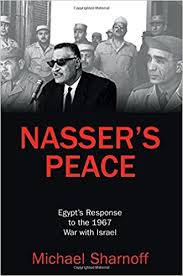|
Reviewed by: Robert P. Barnidge, Jr., PhD, Chaminade College Preparatory School (June 2, 2020) In What Is History?, British historian EH Carr observes that the past becomes “intelligible to us only in the light of the present; and we can fully understand the present only in the light of the past.” Michael Sharnoff’s Nasser’s Peace: Egypt’s Response to the 1967 War with Israel (Nasser’s Peace) helps the reader understand the past and present challenges of Arab-Israeli peacemaking and provides practical guidance in the areas of diplomacy and conflict resolution. The central question that Sharnoff poses is, essentially: what did Egyptian President Gamal Abdel Nasser understand by “peace” in the wake of Israel’s dramatic victory of June 1967, and how did he go about achieving it? Except for Chapter 1, which covers the Free Officers coup of 1952 to the run-up to Israel’s preemptive strike of June 5, Nasser’s Peace focuses exclusively on the six months between June 1967 and the adoption of United Nations Security Council Resolution 242 in late-November. This relatively discrete time period allows the author to look at the main players using extensive archival research and provide depth and nuance to the Arab world’s most consequential leader of the last century. Sharnoff examines four main sources to discern Nasser’s approach to a post-1967 War dispensation: his public statements; private diplomatic consultations with the United States, the Soviet Union, and other notable actors; often caustic Egyptian media accounts by such outlets as al-Ahram and its editor-in-chief and Nasser confidant Muhammad Hassanein Heikal; and diplomatic efforts by Egypt at the United Nations and the Arab League. The author takes the reader through debates in the United Nations General Assembly and Security Council and explores the origins of the “Big Lie” that Nasser (and King Hussein of Jordan) touted that alleged American and British collusion with Israel during those six days in June. Sharnoff shows Nasser sidling up to the Soviet Union while at the same time seeking a thaw in relations with the United States and “positive neutrality” as a leading member of the Non-Aligned Movement. Depending on Nasser’s audience, his balancing of interests, and when he articulated his concerns, the Egyptian leader hovered between a maximalist, pan-Arab stance to placate such Arab radicals as Algeria, Sudan, Syria, Iraq, and the Palestine Liberation Organization and a minimalist, Egypt-first approach of pragmatism and diplomatic savvy (though never countenancing bilateral negotiations with Israel or a peace treaty with the Jewish state). The Americans and Soviets encouraged a diplomatic solution, but “as long as both sides’ [i.e., the Israeli and American and Egyptian and Arab] perception of what precisely constituted peace remained unchanged, Nasser’s supposed campaign to secure a political settlement would remain elusive” (127). This is unsurprising: “peace,” after all, is a most anodyne concept, as Sharnoff recognizes on the first page of Nasser’s Peace. Nasser’s ambiguity after the 1967 War -- for example, speaking of “‘liquidating the traces of aggression’” (64) rather than “‘liquidating Israel’” (64) -- did little to inspire Israeli confidence. How was the Jewish state to know that Egypt did not view its very existence as “aggression,” particularly since Cairo refused to even sit down with Israel to clarify matters? And what (and where) did the larger Arab world mean precisely by its frequent references to “‘occupied Arab territory’” (64) and “‘occupied Palestine’” (64)? Sharnoff is right to question such phrases as “peace,” “aggression,” and “occupied Arab territory” and “occupied Palestine.” His courage in doing so should not be overlooked: sadly, too many “peace processors” cling, almost fetish-like, to any language that might suggest a possible “peace for our time” (without considering the larger context in which language is wielded in the Middle East). Similarly, one could reasonably conclude (or at least not exclude) that the majority of states in the General Assembly that voted in 1975 to condemn Zionism as a “form of racism and racial discrimination” were calling for the elimination of Jewish self-determination (and, by extension, the United Nations Member State of Israel). More worrying still is that several dozen African and Arab states remain wedded to the 1981 African Charter on Human and Peoples’ Rights and 2004 Arab Charter on Human Rights, respectively, both of which expressly call for the elimination of Zionism. Sharnoff concludes that Nasser’s “unwillingness to compromise and formulate a coherent policy prevented Egypt from regaining its territory and dignity, principles that Nasser had so vigorously championed since assuming power” (211). It would take a decade after Nasser’s death in 1970 for his successor, President Anwar Sadat, to achieve this, and to pay for it with his life. |


 Nasser’s Peace: Egypt’s Response to the 1967 War with Israel
Nasser’s Peace: Egypt’s Response to the 1967 War with Israel 